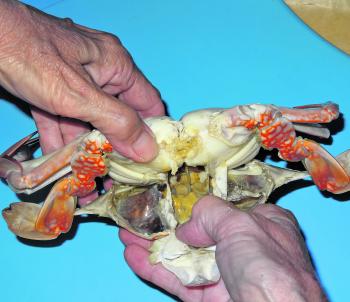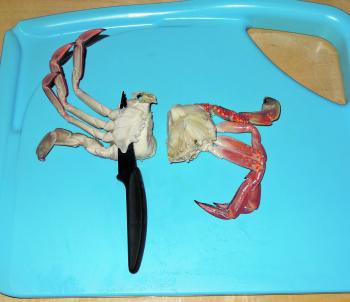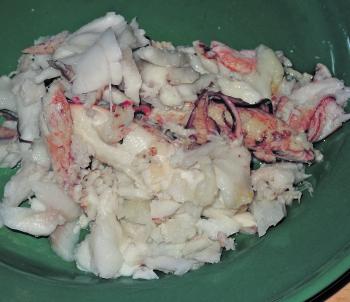There’s so many classic crab meat delicacies: seafood lasagne, crab meat lasagne, the legendary crab sandwich and the cook testing benchmark that is the crab cake. Everybody should have a crab cake recipe in their repertoire, as an example of kitchen skill and understanding of local ingredients. If binders like potato or bread are used, it indicates whether you’re getting a crab cake or a cake flavoured with crab. This month, we look at extracting the meat from a sand crab.
Blue swimmer crabs (‘sand crab’ in QLD, ‘blue crab’ in SA) inhabit coastal waters of Australia. They are caught from northern Queensland to Eden in New South Wales, and from Cape Naturaliste in Western Australia around to the South Australian gulfs. Those areas are subject to different state legislations on what can be caught, so you should check the laws in your state. Otherwise, it’s time to get crabby!
1
Tools required: 1 cooked crab, oyster knife, cleaver, nutcrackers/crab crackers, paring knife, crab pickers, kitchen shears (optional), brush (not shown).
2
First, bring a pot of water to boil. Add crabs to the pot and cook for seven minutes. Once cooked, take the crabs out of the water and remove the two large claws, by breaking them off at the body. Set the claws aside for cracking and removing the meat later. Lift up the tail flap, to start the removal of the top shell (carapace). An oyster knife is handy for cracking apart a crab, and slots in well under the tail flap in order to pry it up.
3
Prise the rear of the carapace away from the body. If you’re having trouble, relocate your effort to one of the ‘points’ and then to the point on the other side. The carapace may also prise away from the front. Don’t despair, it will lever off.
4
Grip the eye-socket frame and mouth. Pull or cut off the face, mouth and eyestalks where they join the body. Remove the internal organs by scraping them out with a knife, brush or spoon. Pull the gills, ‘dead man’s fingers’, off from both sides and discard them into the compost or berley, along with any intestines. If you are in a location where female crabs are a legal take (not Queensland), then any roe should be removed as part of the cleaning. Rinse the crab to remove any muck.
5
Use your cleaver to split the body down the centre. Much of the white meat is located in the chambers, separated by thin walls of cartilage, or shell. To access this meat, use a paring knife and make a flat cut from front to back on the underside of the crab, just above the leg joints. This cut shaves the shell-like ‘top’ off the body, exposing the flesh. Repeat the process on the other side. The legs will give you something to hold onto when making the cut.
6
Lever off, don’t pull, the remaining legs where they join the body. Keep a thumb pressed securely over the body meat when removing the legs. Once the legs are off, use the crab picker to remove meat from the body pieces. Make sure you don’t get cartilage mixed in with the body meat. Crack the joint to give you the biggest part of the claw to work on. Crack the shell less, to avoid the risk of getting small pieces in your cooking. Crack the claw near the scissor joint with either crab crackers or nutcrackers.
7
Gently break the claw open with your fingers and remove the shell, then remove the exposed meat. Remove any flecks of shell and the internal clear membranes. Do this for the other claw. (Alternatively, you can tap the claw with a heavy steak knife or small hammer just below the pincer on both sides, to make a straight, clean cut/crack in the shell.) Open up both pincers to get the meat out. There isn’t much meat inward from a sand crab’s pincers, but you will get a reasonable return on a big mud crab. Crack the knuckle joints, away from all the long pieces, so you only have one section of crab leg to work on. Some of the joints are best sucked out – peeler’s perks!
8
Crack the outer shell of the long piece you are working on, all the way around. Pull the broken pieces apart and lift out the meat. Hopefully it will come in one piece – if not, then employ crab pickers and push the picker through from one end, which will force the meat out of the wider open end. You can also use a crab claw.
9
Some of the smaller leg segments are better squeezed to get the meat out. The crabmeat ready to be used in your crab cakes, next month, should be approximately 125g of meat per blue crab.
Reads: 7037












